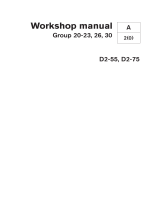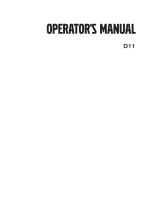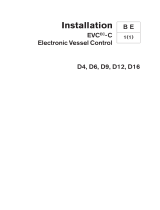
00-0 General
About this Workshop manual
General information
This
Service Manual contains technical data, descrip-
tions and maintenance and repair instructions for
standard model Volvo Penta products. A list of these
products may be found in the section Specifica-
tions.
The product designation and the serial number and
specification is indicated on the engine decal or type
plate. This information must be included in all corre-
spondence regarding the product.
The service manual is produced primarily for the use
of Volvo Penta workshops and their qualified person-
nel. It is assumed that any person using the Service
Manual has a fundamental knowledge of the product
and is able to carry out mechanical and electrical
work to trade standard.
Volvo Penta continually develops its products; we
therefore reserve the right to make changes. All infor-
mation in this manual is based on product data which
was available up to the date on which the manual was
printed. New working methods and significant
changes introduced to the product after this date are
communicated in the form of Service bulletins.
Spare Parts
Spare parts for the electrical and fuel systems are
subject to various national safety standards. Volvo
Penta Original Spare Parts meet these standards. No
damage of any kind caused by the use of spare parts
not approved by Volvo Penta will be compensated by
any warranty undertaking.
Certified engines
When carrying out service and repair on emis-
sion-certified
engines, it is important to be aware
of the following:
Certification means that an engine type has been
inspected and approved by the relevant authority.
The engine manufacturer guarantees that all engines
of the same type are manufactured to correspond to
the certified engine.
This places special demands on service and repair
work, namely:
• Maintenance and service intervals recom-
mended by Volvo Penta must be complied with.
• Only spare parts approved by Volvo Penta may
be used.
• Service on injection pumps, pump settings and
injectors must always be carried out by an
authorized Volvo Penta workshop.
• The engine must not be converted or modified,
except with accessories and service kits which
Volvo Penta has approved for the engine.
• No changes to the exhaust pipe and engine air
inlet duct installations may be made.
• No warranty seals (where present on the prod-
uct) may be broken by unauthorized persons.
The general instructions in the Operator's Manual
concerning operation, service and maintenance
apply.
IMPORTANT!
Neglected or poorly-performed care/service and the
use of spare parts not approved by Volvo Penta, will
mean that AB Volvo Penta no longer guarantees that
the engine conforms to the certified model.
Volvo Penta accepts no responsibility for damage or
costs arising as a result of failure to follow the above
mentioned standards.
2 47704383 06-2013 © AB VOLVO PENTA


























